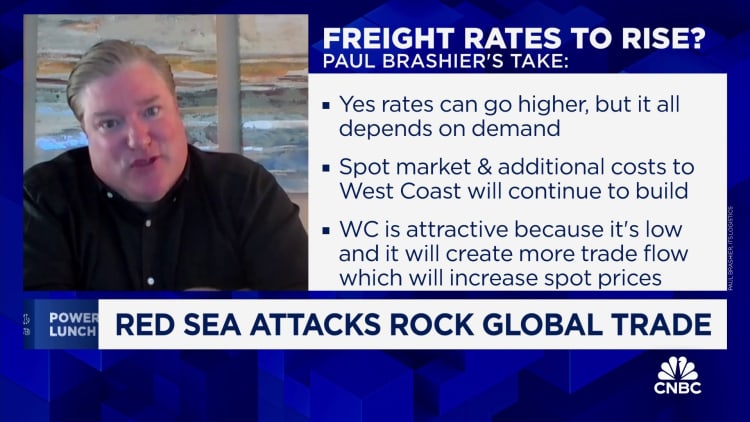Freight ships dock at the Longtan Container Terminal of Nanjing Port to pack and discharge containers in Nanjing, Jiangsu province, China, Sept 6, 2023.
Nurphoto|Nurphoto|Getty Images
A downturn in need for items made in Asia has ocean providers decreasing freight rates on shipping paths from China to the West Coast and canceling cruisings, regardless of raised worries about a brand-new round of supply chain inflation brought on by the Middle East dispute
The freight rate cuts come regardless of the Houthi rebel attacks in the Red Sea which les some carriers to just recently raise container charges as high as $10,000 Delivering giants consisting of Maersk, which have actually needed to stop deliveries through the Red Sea in current weeks, continue to caution of the continuous hazards to the worldwide economy As the U.S. and its allies launch attacks versus the Houthis, worries are running high about an inflation spike for the worldwide supply chain, however the most recent shipping agreement information reveals that on some crucial paths that is not yet taking place.
Rates for brand-new ocean freight agreements arranged to enter into result Monday, January 15 for numerous providers were anticipated to increase above $5,000, however a brand-new advisory to customers from Honour Lane Shipping reveals Asia to U.S. West Coast container rates can be found in listed below that level– U.S. East Coast paths stay greater, at $6,500 to $7,000.
Alan Baer, CEO of logistics business OL U.S.A., stated there seems a growing divergence in between the shipping rates to the U.S. coasts. “U.S. West Coast rates have actually rolled over and are reducing,” Baer stated.
More carriers were anticipated to begin preventing the East Coast and prefer the West Coast ports as an outcome of the Middle East problems. Diversions from Egypt’s Suez Canal, which feeds into the Red Sea, and the rerouting of vessels around the Cape of Great Hope includes 2 to 4 weeks to a round-trip trip, according to Honour Lane Shipping, and ocean providers require more ships on each Asia-East Coast path to preserve an effective network schedule.
However Baer states the information does not support the view that the circumstance has actually moved more trade to West Coast paths. ” Maybe the diversion far from the U.S. East Coast has actually not triggered as considerable a boost to U.S. West Coast volume as very first prepared for,” he stated.
Baer states there might possibly be more cancelled cruisings to come in February to assist stabilize real supply and need.
Still, rates remain in flux, responding to a really delicate market, and rates pressures will stay, according to Goetz Alebrand, head of ocean freight for the Americas at DHL Global Forwarding.
” Ocean freight rate modifications are made in the exact same weekly nowadays,” stated Alebrand. “It might be viewed as a change to provide and require. We anticipate this circumstance to stay fluid however usually see more opportunities for rates to stay raised.”
The continuous dry spell problems at the Panama Canal, which today led Maersk to re-route some freight by a “land bridge,” are contributing to the worldwide freight intricacies.
C.H. Robinson explains the existing worldwide ocean shipping circumstance as one in which customers need to move rapidly to protect area in “a competitive capability market,” according to a current commentary from Matthew Citizen, vice president of worldwide ocean services, and it suggests scheduling a minimum of 3 to 4 weeks beforehand for ocean freight on all paths.

Under the U.S. Shipping Act, all ocean providers need to offer 30-day notification before they can enforce additional charges or GRIs, however the Federal Maritime Commission has actually waived this for deliveries from Asia to the U.S. being rerouted around South Africa’s Cape of Great Hope.
Maersk decreased to discuss brand-new agreement rates, mentioning a peaceful duration. CNBC connected to other significant ocean providers for a remark, however did not get instant actions.
A decline in Asia making need is the factor behind a choice from MSC, the world’s biggest provider, to cancel cruisings. “MSC prepares to change its capability in line with the downturn in need on Asia– U.S.A. and Canada paths due to the Chinese New Year duration,” it stated in a current advisory to customers.
The decrease in China freight need remains in line with a CNBC Supply Chain Study projection for 2024 in which logistics executives who handle freight production orders and transport– consisting of those at C.H. Robinson, SEKO Logistics, DHL Global Forwarding Americas, Kuehne + Nagel, OL U.S.A. and ITS Logistics– cautioned of a reduction in need ahead of Lunar New Year.
